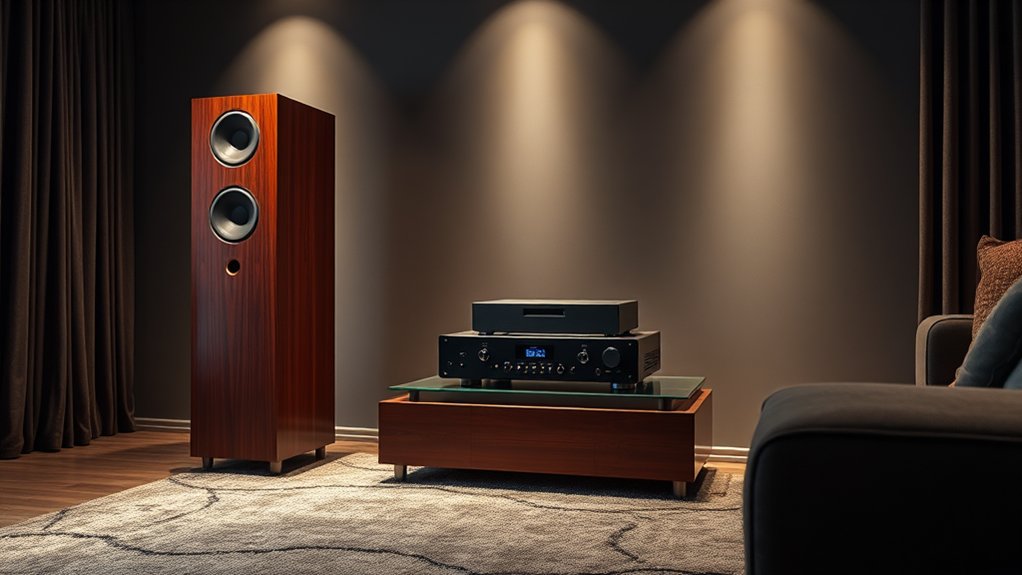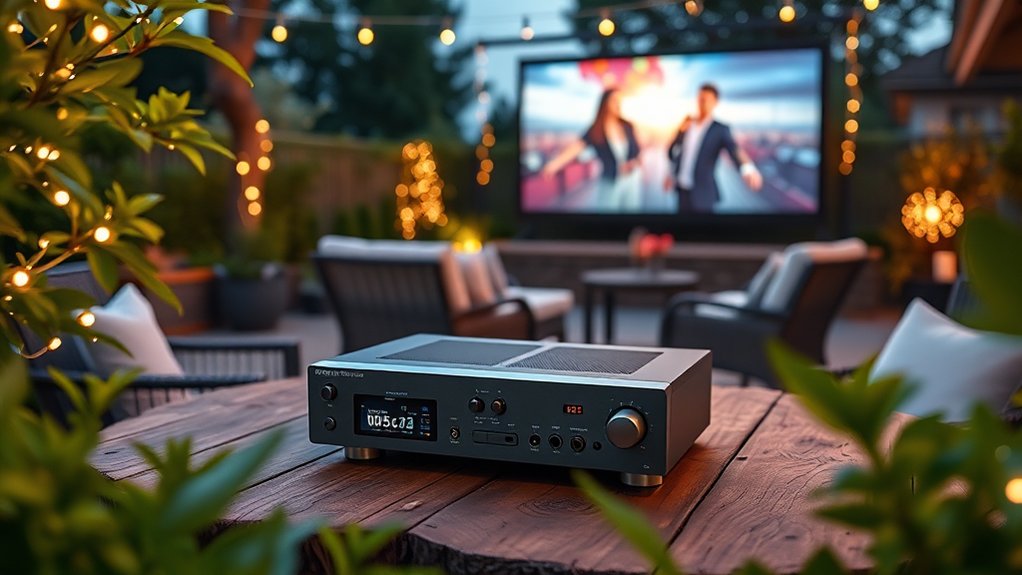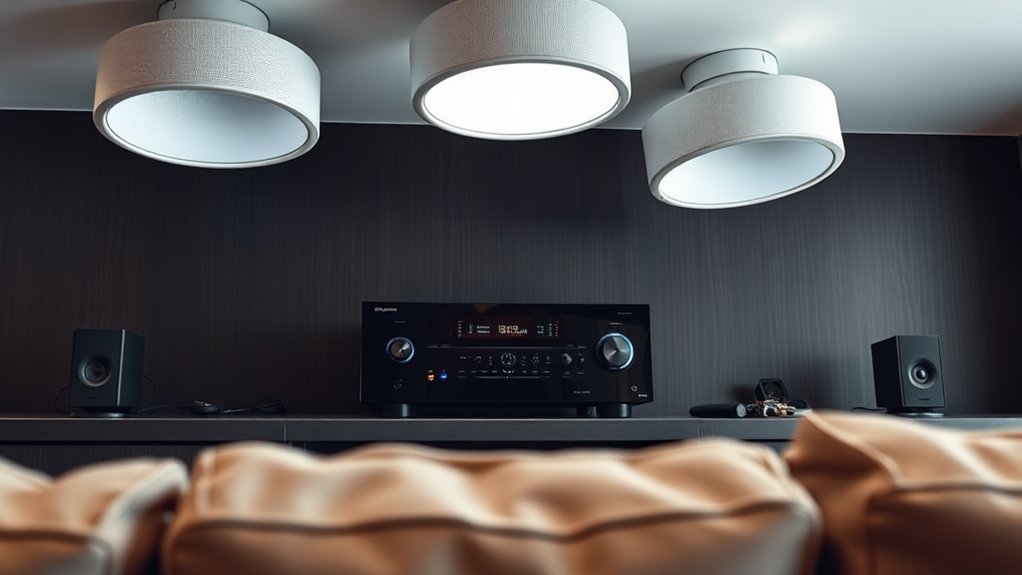When choosing high power amplifiers for your floor speakers, consider matching the amplifier’s output to your speakers’ continuous power rating, ideally 1.5 to 2 times more. Make certain the impedance aligns—8 ohms is standard—to avoid strain. Look for high sensitivity speakers since they need less power for maximum volume, and don’t forget to assess specifications like frequency response and low distortion. Got your acoustic setup in mind? There’s more to investigate on optimizing your audio experience!
Key Highlights
- Ensure the amplifier delivers 2 to 4 times the continuous power rating of your floor speakers for distortion-free sound and peak handling.
- Match the amplifier’s impedance with the speakers, typically 4 or 8 ohms, to prevent damage and ensure efficient operation.
- Look for amplifiers with a frequency response of 20 Hz to 20 kHz and low Total Harmonic Distortion for superior sound quality.
- Consider high-efficiency Class D amplifiers that operate up to 90% efficiency, reducing wasted power and operating costs.
- Prioritize auditioning the equipment in a quiet setting to assess sound clarity, balance, and avoid distortion across different frequency ranges.
Understanding Amplifier Power Output Requirements

When you’re diving into the world of floor speakers, one of the most critical aspects you’ll encounter is understanding amplifier power output requirements.
You want an amplifier that delivers 2 to 4 times the continuous power rating of your speakers. This extra power, often called headroom, lets you enjoy peaks without distortion. For a typical home stereo setup, 150 watts should suffice for an average listening experience, but if you’re jamming out at a rock concert, you might need over 1000 watts! Remember, floor speakers, with their multiple drivers, typically demand more power than their smaller counterparts. By being aware of power amplifier requirements, you can select the right amplifier to ensure your speakers perform optimally. Additionally, it’s important to pair speakers with compatible amplifiers to achieve the best sound quality.
Matching Speaker Impedance With Amplifier Compatibility
Understanding how to match the impedance of your speakers with your amplifier is crucial, especially if you want to maximize audio performance without risking damage to your gear.
Typically, speaker impedances range from 4 to 16 ohms, with 8 ohms being the star of the HiFi show. It’s best to align your speaker impedance with your amplifier’s rating, ideally sticking within the recommended range to avoid strain—think of it as project management for your sound system. Checking Ratings on both speakers and amplifiers ensures compatibility and prevents potential issues. Additionally, improper matching impedance can cause permanent damage to speakers or the receiver.
Speaker impedances typically range from 4 to 16 ohms, so match them with your amplifier’s rating for optimal performance.
Don’t try to pair a low-impedance speaker with an underrated amplifier, except if you enjoy the sound of sizzling electronics. On the flip side, avoid excessively high impedance, as it can limit your volume.
Just remember, matching impedance means happier equipment and better sound!
Importance of Speaker Sensitivity and Efficiency
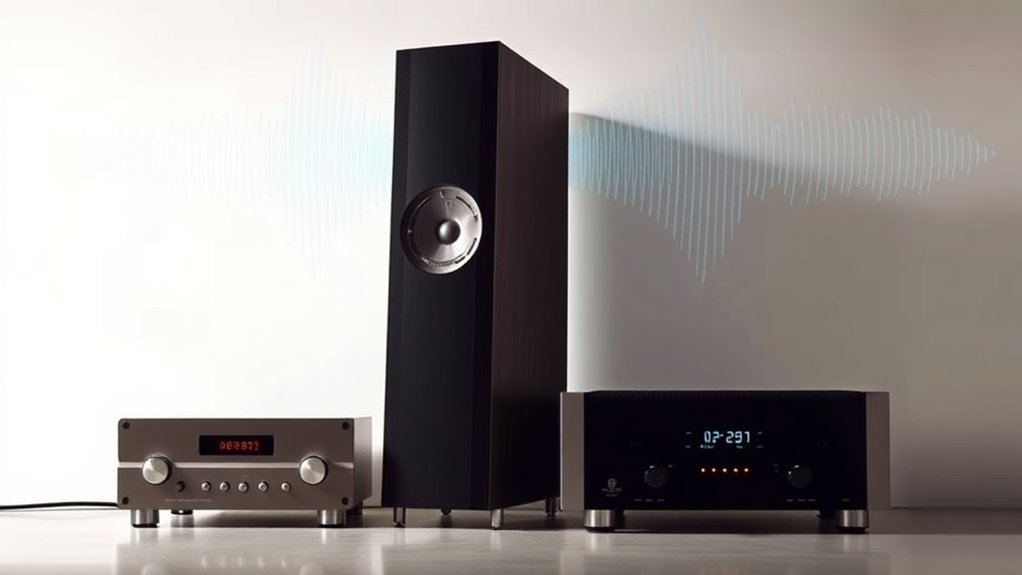
Matching impedance is just one piece of the speaker and amplifier puzzle; now let’s shine a light on speaker sensitivity and efficiency, two traits that are just as important for a harmonious audio experience.
Speaker sensitivity measures how loud your speakers get with just one watt of power, whereas efficiency gauges how well they convert electrical power into sound, which, let’s face it, is pretty important if you want to rock out without the risk of distortion. Additionally, acoustic efficiency is crucial as it determines the output acoustic power relative to the electrical input power, impacting overall sound performance.
High-sensitivity speakers need less power to deliver the same volume as their low-sensitivity counterparts, making them easier to drive and typically more cost-effective.
Key Specifications for Floor Speaker Amplifiers
Choosing the right specifications for floor speaker amplifiers is crucial, particularly if you want to improve your audio experience without the risk of a sonic disaster.
First, verify the amplifier’s power output is 1.5 to 2 times greater than your speakers’ continuous power rating; this headroom prevents clipping during loud passages. Match the amplifier’s impedance (usually 4 or 8 ohms) with your speakers to avoid potential damage.
Additionally, check the frequency response; a range of 20 Hz to 20 kHz is ideal for accurate sound reproduction. And don’t overlook Total Harmonic Distortion (THD) and signal-to-noise ratio—lower values are better for clear audio.
Assessing Acoustic Environment and Listening Preferences
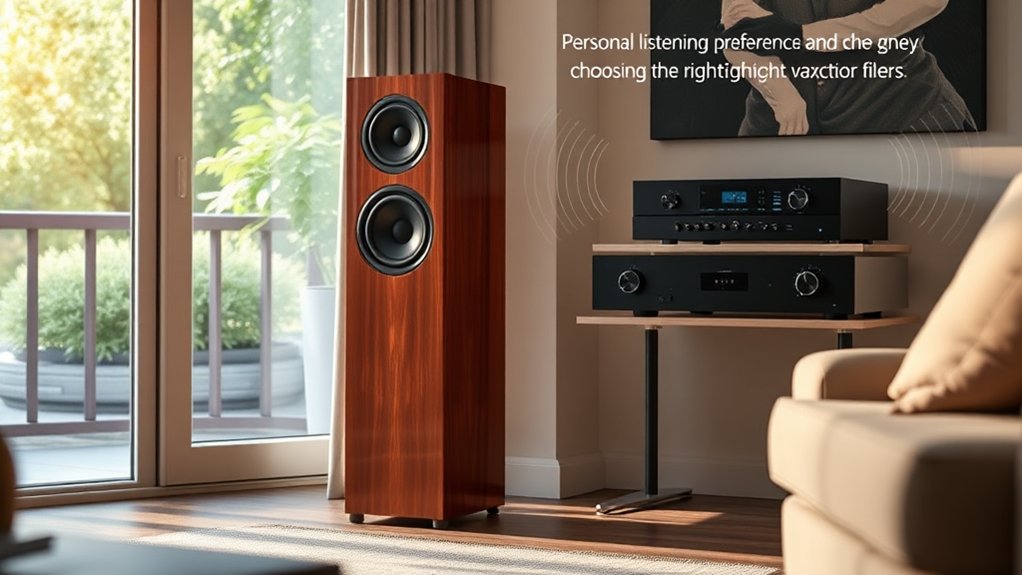
How much do you really consider your acoustic environment when selecting an amplifier for your floor speakers?
The space you listen in can greatly shape your audio experience, altering how sound waves interact within the room. For instance, rooms with hard surfaces reflect sound, whereas softer surfaces absorb it, affecting volume and clarity.
If your room’s loudness and dynamic range are challenging, you’ll need an amplifier that can deliver power without distortion.
You should additionally consider your listening preferences: Are you a casual listener or a critical audiophile?
Selecting Amplifiers Based on Power Supply and Installation Needs
Once you’ve taken the time to evaluate your acoustic environment and listening habits, it’s time to focus on the nitty-gritty of power supply and installation needs for your amplifier.
You’ll want to make certain the amplifier’s power rating matches your speakers’ continuous power requirements to avoid distortion or damage. Typically, aim for an amplifier that provides 1.6x to 2.5x the speaker’s power for added headroom during dynamic music passages.
You likewise need a stable power supply to avoid clipping and maintain sound quality, especially during high volumes. Think about the installation space—proper ventilation is key, and dedicated circuits can help keep things running smoothly. Also, consider the Polk Audio T50 tower speakers that are designed to deliver clear highs and substantial bass, making them an excellent choice for high power amplifiers.
After all, nobody wants their dreams of a perfect sound system derailed by a meltdown, right?
Evaluating Connectivity Options for Flexibility
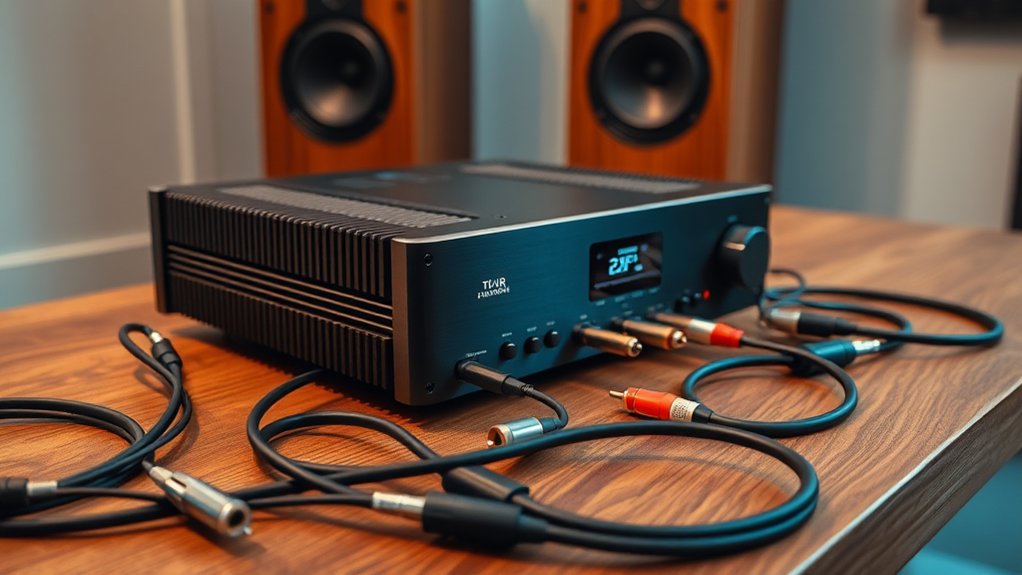
Evaluating connectivity options for your high power amplifiers and floor speakers is crucial, as it can make or break your audio experience.
You’ve got options like banana plugs, XLR, and 6.35mm jacks; each has its quirks. Although banana plugs are popular for their ease and reliability, those in professional setups might prefer Speakon connectors to prevent accidental disconnects, especially during a live performance.
Plus, RCA or XLR connectors allow for flexibility, connecting to various devices with ease.
RCA and XLR connectors offer versatility, ensuring seamless connections across different audio devices.
Certainly, bare wire connections work, but don’t they seem like the DIY choice? Ideally, you want reliable connections that maintain signal integrity—after all, you wouldn’t want your audio quality to depend on sheer luck, right?
Considering Energy Efficiency and Operating Costs
Why should energy efficiency and operating costs matter when choosing high power amplifiers for your floor speakers? Well, think about it—every time you crank up those tunes, your amp uses energy. High efficiency amplifiers, like Class D models, can deliver up to 90% efficiency, translating to less wasted power and lower electricity bills.
If you opt for less efficient models, they’ll generate more heat, which not only costs you in energy but might require cooling solutions too. Plus, matching your amp’s power rating to your speakers helps avoid distortion during maximizing performance.
Investing in energy-efficient models keeps your setup running smoothly and saves you cash without sacrificing sound quality—because who doesn’t want to rock out without breaking the bank?
Auditioning Equipment for Optimal Performance
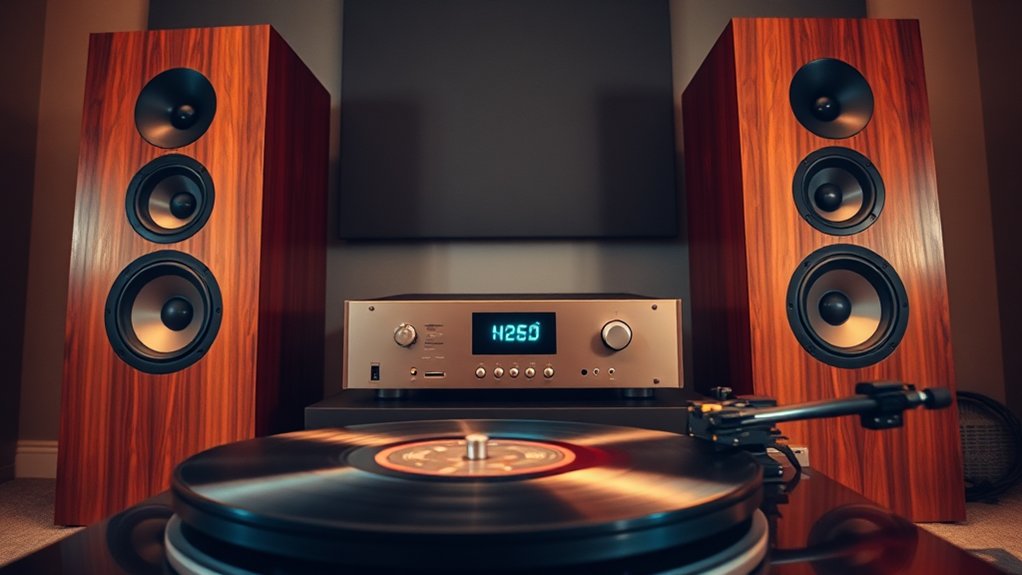
When you’re looking to get the best sound from your floor speakers, auditioning your equipment isn’t just a box to check—it’s a critical step in achieving that rich, immersive audio experience you crave.
Start by choosing a quiet room, as ambient noise can skew your perception of sound. Position your speakers away from walls to avoid unwanted reflections.
When you’re seated at ear level, it helps you appreciate the sweet spot of sound. Use high-quality tracks; after all, you wouldn’t test a sports car with a tricycle!
Confirm amplifier power matches or exceeds your speakers’ needs to avoid distortion. Finally, listen for clarity across different frequencies. If it doesn’t deliver, don’t settle—your ears deserve the best!
Frequently Asked Questions
Can I Use a Home Theater Receiver With Floor Speakers?
Yes, you can use a home theater receiver with floor speakers. Just make sure the receiver’s power output matches the speakers’ capacity and impedance ratings are compatible to enjoy the best sound quality without damaging them.
What Is the Ideal Amplifier Size for a Small Room?
To determine the ideal amplifier size for a small room, consider using one rated between 20-50 watts per channel. This’ll provide adequate volume without overwhelming the space or causing sound distortion. Balance is key!
Do Expensive Amplifiers Always Produce Better Sound Quality?
Expensive amplifiers don’t always guarantee better sound quality. You might notice differences, but your ears and speakers’ limitations can impact perception. Sometimes, well-matched budget options deliver satisfactory results without breaking the bank.
How Often Should I Maintain or Service My Amplifier?
You should maintain your amplifier monthly for basic checks, and have it professionally serviced annually. This keeps it in top shape, guarantees peak performance, and prolongs its lifespan, so you can enjoy the best sound quality.
Can I Connect Multiple Floor Speakers to One Amplifier?
Yes, you can connect multiple floor speakers to one amplifier. Just confirm the total impedance matches your amp’s rating and that you’re not exceeding its power output to avoid distortion or potential damage.

